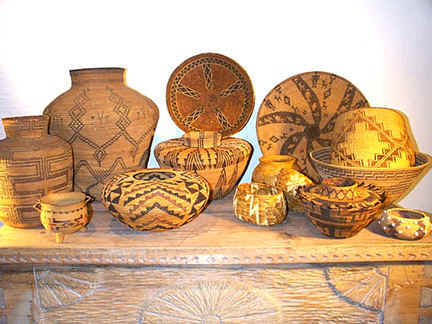|
Our Current Inventory of Antique Baskets can be found HERE

Len Wood's Indian Territory, Inc. -- with galleries located in Laguna
Beach, California since 1969 -- maintains the nation's largest selection
of antique PRE-1930 native North American Indian baskets including
basketry examples from Arizona and the Southwest tribes (including the
Apache and the Pima), the Great Basin of Nevada (including Indian baskets
of the Panamint, Chemehuevi and Washo Indian cultures), Southern
California Mission Indian baskets, Indian baskets of the central
Californian Yokuts, Maidu, Pomo, Mono, etc., Northern California Indian
baskets of the Hupa, Karok and Yurok, as well as Indian baskets of the
Pacific Northwest Coast including the Tlingit and Eskimo.
Our Current Inventory of Antique Baskets can be found
HERE
Available American Indian Baskets
(Online Catalog to View or Purchase Baskets)
How to Sell your Indian Basket Collection
Free Appraisals of Your Indian Basket Collection
Brief Overview of Indian Basket Collecting©
By Jeff Wood
Len Wood's Indian Territory Gallery
Laguna Beach CA
The many dozens of Native American tribal cultures, and
hundreds of tribal sub-culture groups, of the Western US produced what
many collectors consider the world's finest basketry. These basket-weaving
cultures include the Apache and Pima of Arizona, the Panamint of the
Eastern California desert and the Chemehuevi, Washo and Paiute of the
Great Basin of Nevada, the various Mission Indian cultures of Southern
California, the Yokuts, Mono, Maidu and Pomo of Central California, the
Yurok, Hupa and Karuk/Karok of Northern California and the Tlingit, Haida
and Thompson River cultures of the Pacific Northwest Coast among them.
At the end of the 19th century and beginning of the 20th century basketry
of the Western US tribal cultures was being made primarily for sale and
trade to trading posts, dealers and collectors. The Industrial Revolution
had brought inexpensive cast iron pots and pans to the west at the same
time that tourism to western tribal reservations was increasing by train
and via the newly mass-produced automobile. Special juried festivals such
as "Field Days" at Yosemite National Park hosted exhibitions of the finest
baskets and their weavers and wealthy collectors would compete to acquire
the finest examples. Weavers competed to weave the most refined and more
aesthetically pleasing examples to meet the needs of the market.
The Great Depression of the 1930s brought the end of traditional basket
weaving for most tribes, especially for those cultures where the greatest
skill and most difficult weaving technology was practiced. In that fifty
year window of time from the end of the Indian Wars/early reservation
period of 1880 to the beginning of the Great Depression of the 1930s an
Early Collector Period existed in which basketry attained a peak in
quality and refinement. While contemporary baskets of some forms are still
woven by some of the cultures today, baskets of this early era are among
the most eagerly sought by collectors.
Each culture used weaving materials native to their region and forms and
weaving techniques that had been passed down through untold generations.
For example, in Arizona both the Apache and the Pima wove baskets out of
split and sized willow shoots and split devilsclaw seedpod, however the
finest Apache baskets were woven on a three-rod foundation which made for
a very rigid basket with well rounded rib-like coils. The Pima wove on a
grass bundle foundation which yielded a flatter coil and a slightly
flexible basket. The traditional basketry forms of the Apache and Pima
include tall vase-shaped grain storage jars known as ollas,as well as
shallow and deep trays and bowls of various sizes and shapes. The shallow
trays which can run from under six inches diameter to over twenty inches
diameter can feature geometric motifs such as whirlwinds, floral
/cactus/squash blossom and other plant motifs ,sun, star or lightning
inspired geometric motifs or figurative motifs such as human forms,
coyotes ("dogs"), cactus, stars, crosses, spirit figures, deer and others.
While some of these cultures continue to weave today very few are made
using the same technology as the ancestors. For example, the Apache
continued to weave twined burden baskets after the 1930s but relatively
few coiled, three rod foundation baskets and the few made were often woven
with larger stitch and blockier motifs—a result of both the break in the
chain of weaving knowledge and the economic shift that did not allow for
the time commitment to finer weaving. The Pima in recent years have
focused on horsehair miniature baskets for the most part. After the 1930s
the Papago or Tohono O Odham would continue to weave in yucca while giving
up weaving in willow. Yucca baskets could be woven quickly, sold at a
modest price to the mid and late 20th century tourist and curio market and
still yield a profit to the weaver. Revival of willow basketry and three
rod foundation basketry takes place from time to time with various degrees
of success however the majority of collectors as of this writing still
express a preference for historic era examples.
California is home to the largest number of fine basketry weaving cultures
and the greatest diversity of forms, materials and weaving technologies.
The Southern California cultures from the Kumeyaay of the San Diego region
to the Cahuilla of Palm Springs and north to the Chumash of Santa Barbara
have been collectively grouped and known as "Mission Indians" in mass
culture ( a reference to the Spanish Mission system in early California
history). In basket weaving all Mission Indian cultures except Chumash
(which weave on rod foundation) share a coiled on bundle weaving
technology with a diagonally tucked stitch end and use a combination of a
native Californian plant called juncus – with its distinctive gold to red
coloration , combined with an even, light colored sumac and dyed juncus
(juncus that had usually been mud-dyed to a dark brown or black color) in
some combination in all their baskets. Many of the basket weaving cultures
would spend a great deal of time in caring for and maintaining the native
plants before harvesting, and in cutting and sizing plant materials to a
uniform diameter prior to weaving.
Unlike Southern California coiled baskets, Northern California baskets
were primarily twined of various tree and fern roots and made in hat/cap
forms, bowl forms, cradles and trays.
Central Californian basketry was quite varied and included the delicate
feathered baskets of the Pomo, used originally as wedding dowry and then
after 1880 primarily for trade to collectors, to the acorn feast bowls of
the Yokuts and Maidu who could cook acorn mush and acorn soup inside a
basket without burning it by placing hot stones on top of the mush and
letting the mush itself protect the basket from the hot stone.
Today, most active collectors seek the rarest, finest and best examples
their budget can afford. While a few cultures have relearned some of the
skills required to make excellent baskets today and are developing markets
for them, for most collectors pre-1930 baskets represent the unbroken
chain of teaching before it was interrupted by compulsory government
education (often at boarding schools which made teaching the next
generation of weavers difficult to impossible), the lack of necessity for
baskets among the tribal cultures themselves-- brought by the cheap
storage pans and pots of the Industrial Revolution, and loss of collector
market for a prolonged period and the resulting change in the economics of
basket weaving brought by the Great Depression.
Today, some basket collectors seek items from a particular culture or
region--perhaps the region in which they live; others seek a top example
from many different tribal cultures, while still others seek examples that
meet a particular need of a display environement. Collectors display trays
and shallow bowls on display stands as well as directly on the wall by
using a needle and thread to make a small loop which can be placed on a
picture hook on a wall. Ollas and bowls are typically set on tables,
shelves and mantels. All forms are also displayed in cabinetry with china
and crystal cabinets making excellent basket collection display cases for
small to medium sized examples.
Basketry is one of the world's oldest art forms and technologies and is
being collected today both by those decorating their home or office in
antiquities as well as by those collecting primarily for investment
purposes. While homes featuring Craftsman, Ranch, Spanish Colonial, Pueblo
and similar architectural or interior décor styles are natural showcases
for fine native basketry, basketry is also found in modern corporate
offices and alongside modern and contemporary art as well, as the timeless
sophistication and refinement found in most basketry can find points of
interconnection with other art-forms from all cultures.
Native basketry tends to unite people of varied backgrounds, belief
systems and political perspectives-- people who might not reach agreement
on any other subject—into a mutual appreciation of the skill and
sophistication of these early cultures which were able to combine form and
function, utility and art within a single work. Basket collecting is a
common ground where many new friendships are made and provides the
collector with a direct touchstone to America's past, great unwritten
history.
In addition to its universal appeal, history and use in decorating and
display, many collectors are also viewing Native American basketry as an
investment in art, antiquities and collectibles.. Collections are
appraised and re-appraised at regular intervals and insured on homeowners
policies. The selling and / or donating of a basket collection is becoming
an important factor in many collectors long term investment plans.
Within each basketry culture and each form there are standards of
refinement and excellence and baskets are generally judged by collectors
in relation to both the best that the particular culture was known to
produce within a form as well as the best currently available in that
form. Collectors have been inspired to publish books on their basket
collections and sponsor public exhibitions to share their love of basketry
and basketry collecting. Most surviving examples of early baskets are in
the hands of the descendants of the collectors of that Early Basket
Collector Period 1880-1930 and can be found today in antique stores,
auctions and galleries featuring Native American antiquities.
Developing a deep reference library as well as relationships among basket
dealers and fellow collectors is important in the development of a fine
collection. It is important for new collectors to note that American
Indian basketry is relatively rare as most of the tribal basketry of the
world is made in Africa and Asia and many a new collector purchase what
they think is a Southwestern Indian basket of some kind at a garage sale
or swap meet only to discover later that it had its origins on another
continent. Until a collector is sufficiently experienced to make
completely independent evaluations, its important for new collectors to
obtain both documentation of authenticity and money back guarantee of
authenticity when purchasing and to acquire from known sources with whom
the collector has established an ongoing relationship.
Len Wood's Indian Territory Inc copyright 2008
Requests for reprint by written permission only and to
include quotation in full with authorship credits to both Len Wood's
Indian Territory Inc as well as to this website
www.indianterritory.com Email
requests to:
info@indianterritory.com
Below are links to our Additional Articles & Information on
North American Indian Baskets
If you prefer to go directly to our Online Catalog of
Available
Indian Baskets - Click Here
|

